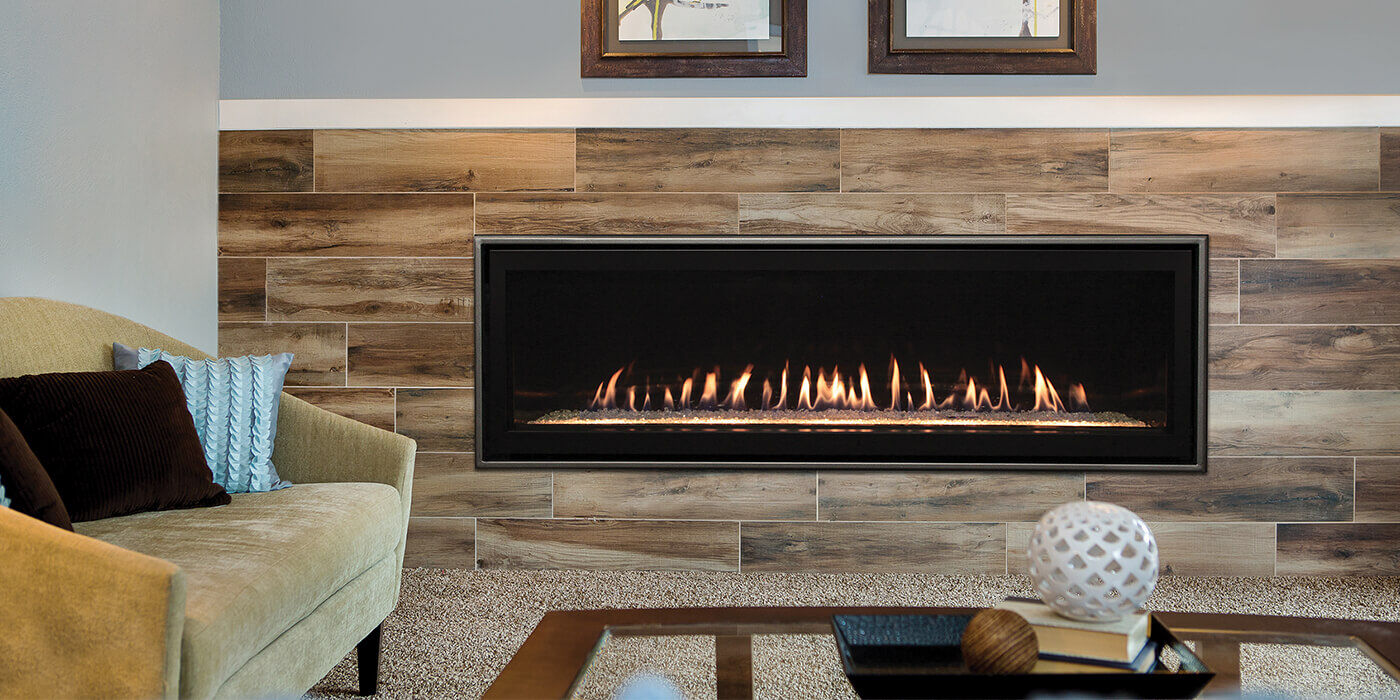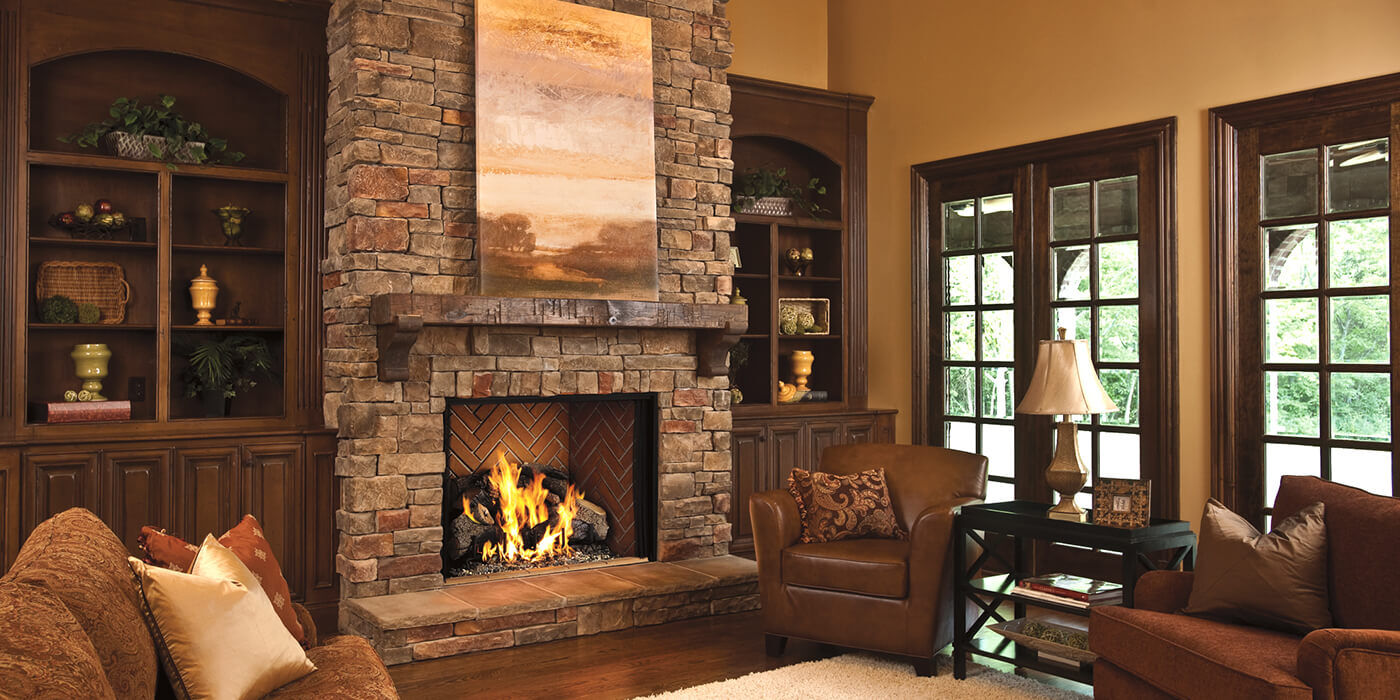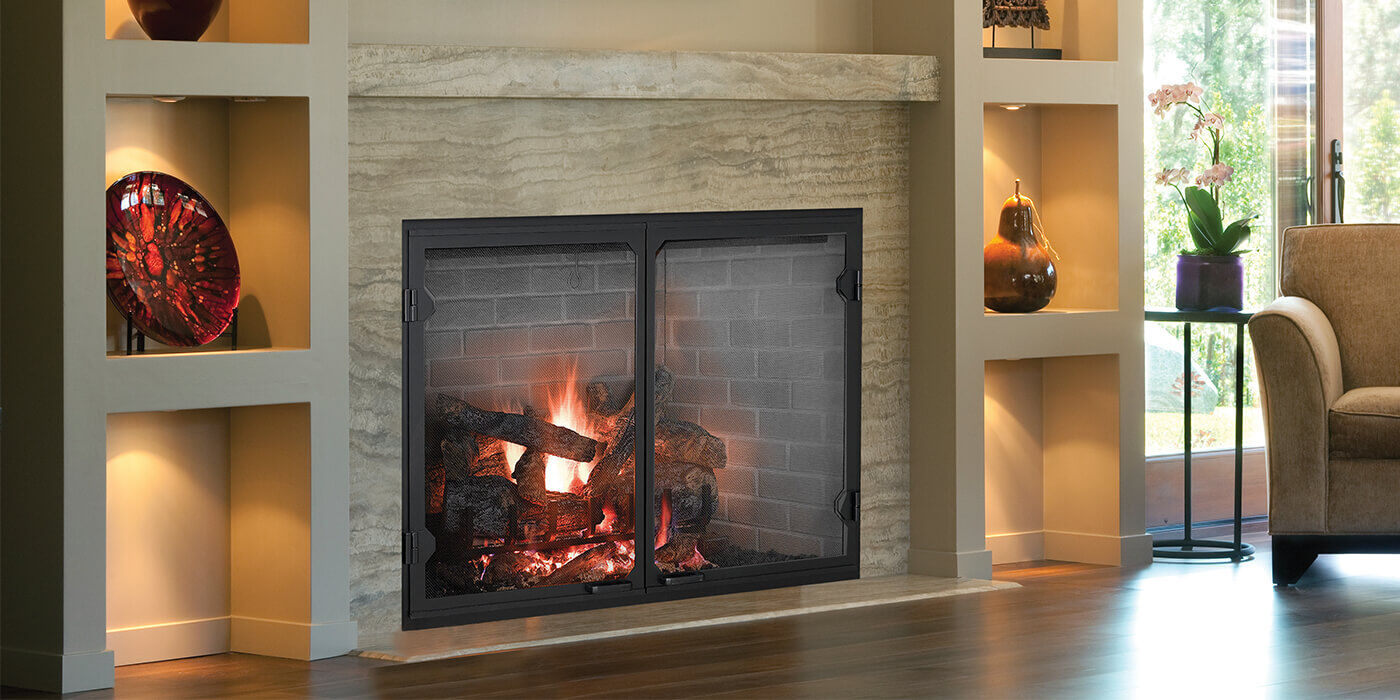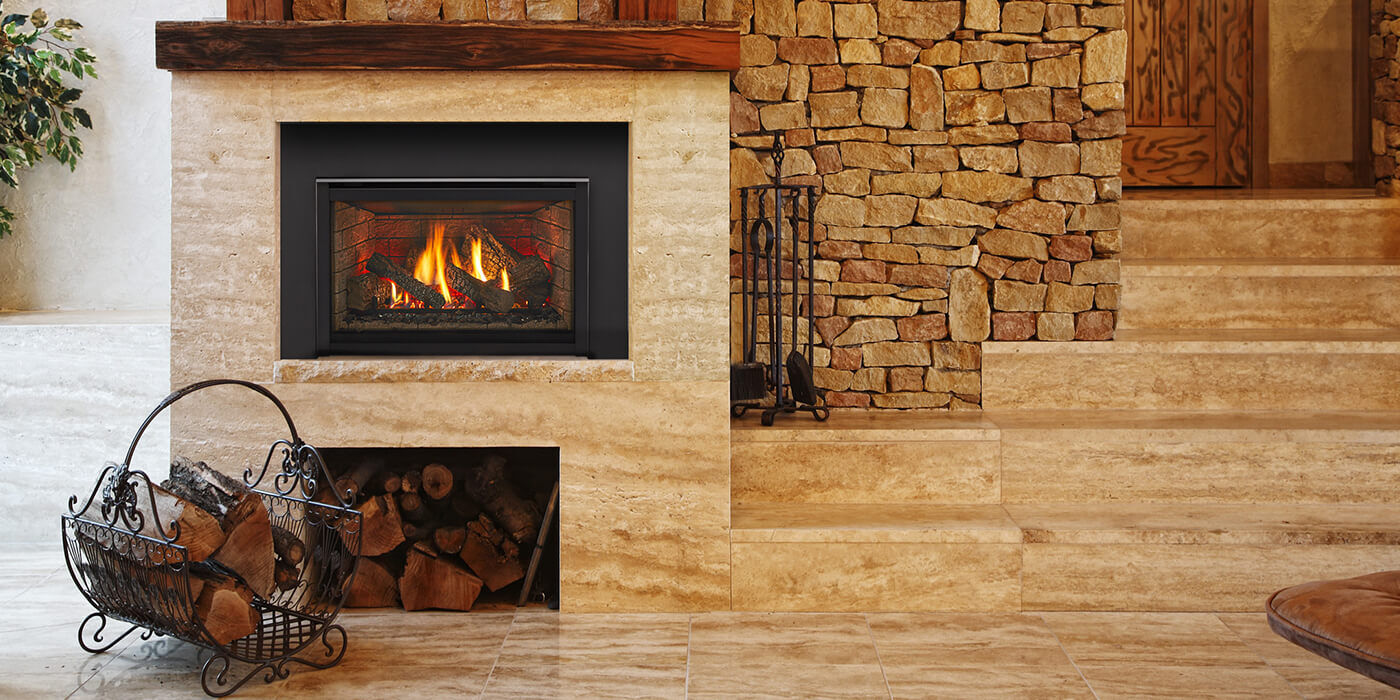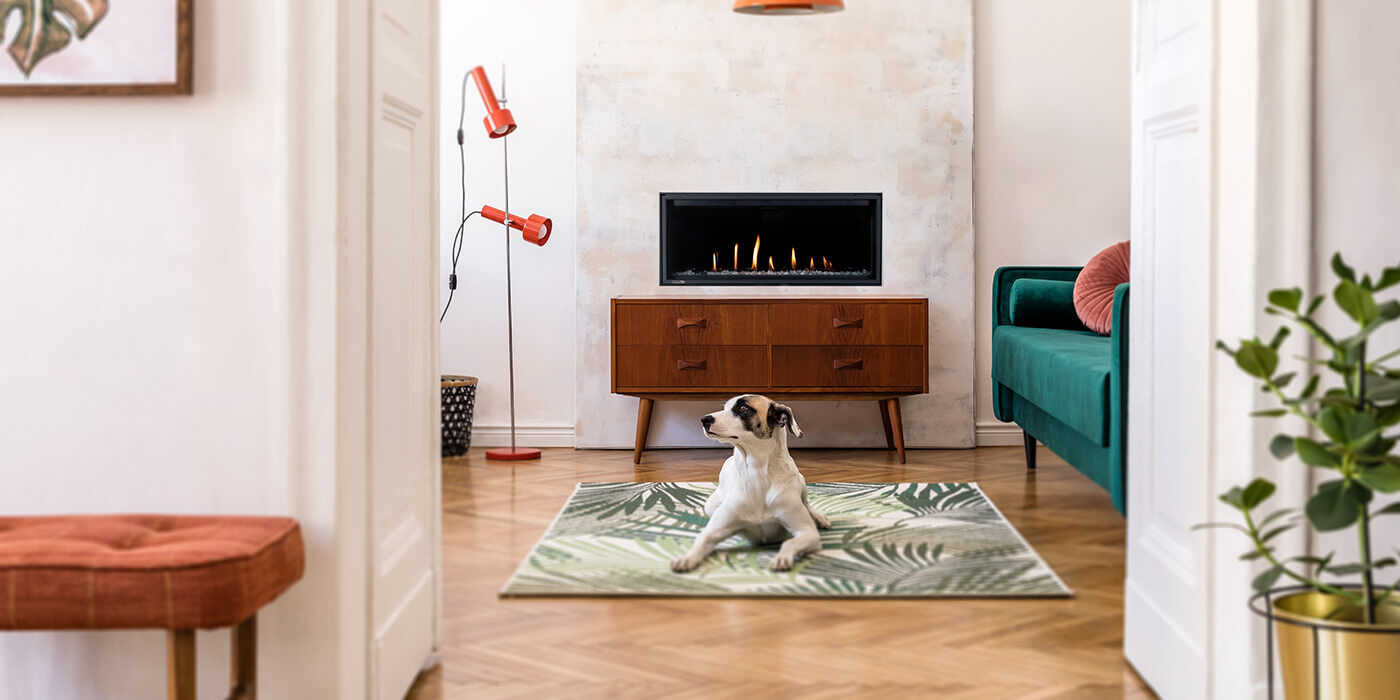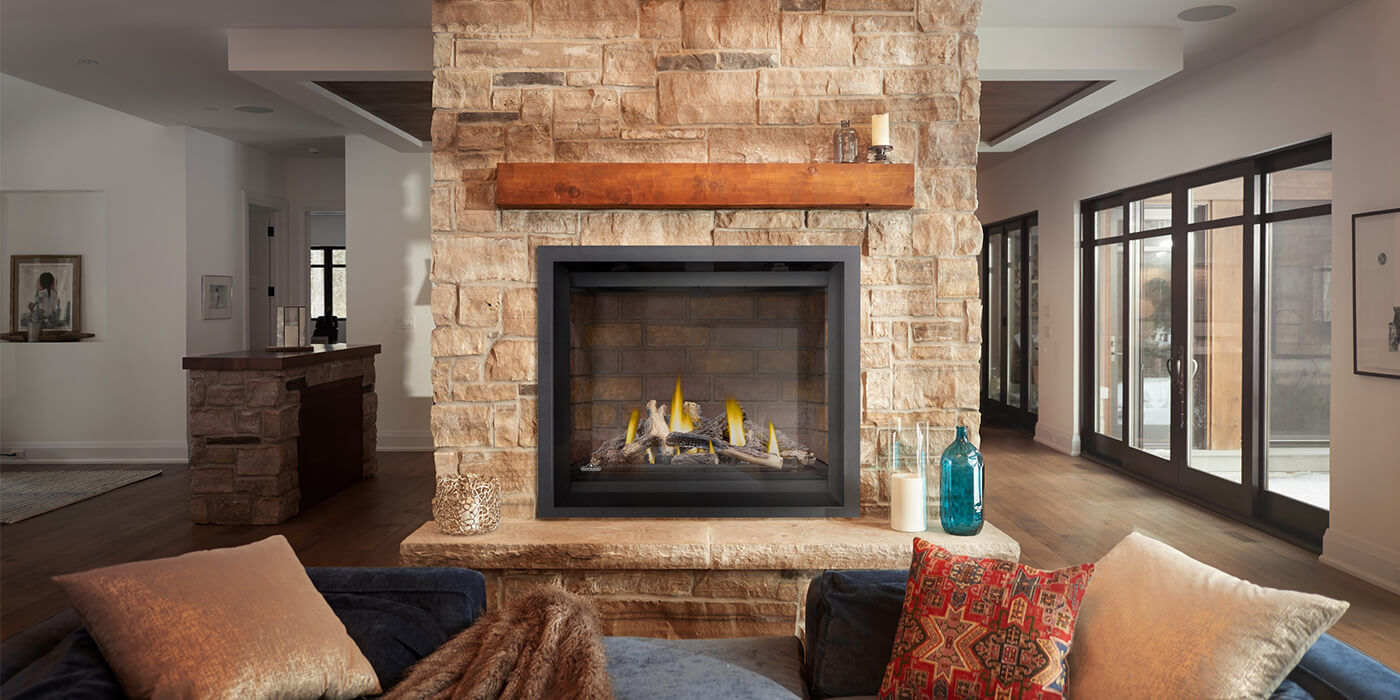By: Garrett Jamieson, NFI Certified Master Hearth Professional
Last Updated: October 23, 2025
There’s nothing quite like gathering around a warm, crackling fire — but if your fireplace isn’t putting out enough heat, you might be losing more warmth (and money) than you realize.
Fireplaces are designed to bring comfort and ambiance to your home, yet many homeowners don’t realize how much heat can escape through inefficiencies in the fireplace design, chimney, or operation.
Whether you have a wood burning fireplace, gas fireplace, or electric model, there are practical ways to maximize fireplace heat and improve your home’s overall efficiency.
Below, we’ll explore expert fireplace energy tips to help you make the most of every flicking flame.
In This Article
- How fireplaces produce & lose heat
- Close the damper
- Use a fireback
- Install glass doors
- Add a fireplace insert
- Check your chimney/venting system
- Burn seasoned firewood
- Install a blower/fan
- Seal leaks around fireplace
- Upgrade to a high-efficiency model
- Set up zone heating
- Schedule regular fireplace maintenance
- Bonus fireplace energy saving tips
- Summary
- FAQs
Understanding How Fireplaces Produce (and Lose) Heat
Before diving into the fixes, it helps to understand where fireplace heat goes.
Wood burning fireplaces often send more heat up the chimney than into the room — as much as 80–90%. Without proper sealing and airflow control, these traditional, timeless hearths can act more like a heat vacuum.
Gas fireplaces are typically more efficient, especially Direct Vent models that seal combustion air from the room and vent exhaust directly outside. Still, they need proper maintenance and settings to perform their best.
While electric fireplaces don’t produce real flames, they convert nearly all their energy into heat. The challenge is optimizing heat distribution throughout your home.
Once you understand how your fireplace transfers heat, you can select the right improvements — without sacrificing that cozy ambiance.
Close the Damper When Not in Use
Think of your fireplace damper as a window to the outdoors. When left open, warm indoor air escapes up the chimney, pulling cold air into the room.
After the fire has gone out completely and the ashes are cool, close the damper tightly to prevent heat loss.
If you have an older damper that doesn’t seal properly, consider upgrading to a top-sealing chimney damper, which offers a much tighter fit and can significantly improve fireplace efficiency.
Use a Fireback to Reflect Heat
A fireback is a metal plate — usually cast iron or stainless steel — that sits at the back of your fireplace. It reflects heat back into the room rather than letting it disappear up the flue.
Available in a wide variety of decorative styles, firebacks are a simple and attractive way to boost radiant heat output, while protecting the back wall of your fireplace from damage.
Install Glass Doors
Glass fireplace doors do more than add style — they also help maximize fireplace heat by reducing the amount of warm room air from being drawn up the chimney. When closed, they act as a barrier, allowing radiant heat to pass through while keeping drafts out.
If you have an open-hearth wood burning fireplace, this is one of the most cost-effective upgrades you can make for efficient fireplace heating.
Add a Fireplace Insert
A fireplace insert is essentially a self-contained heating system that fits inside your existing fireplace opening. There are gas, wood, and electric fireplace inserts available, each designed to dramatically improve heating efficiency.
Wood burning fireplace inserts, for example, can achieve up to 75–80% efficiency. Gas inserts often reach over 70%, making them one of the best ways to convert your fireplace into a serious heat source.
Check Your Chimney and Venting System
Even the best fireplace can’t perform well if the chimney or vent is dirty, damaged, or improperly sized. Regular chimney maintenance is essential for safe, efficient operation.
Have your chimney inspected and cleaned at least once a year by a certified professional to prevent the buildup of soot, creosote, or debris.
For gas fireplaces, ensure the venting system and termination caps are clear and properly sealed. Blocked or leaky vents can lead to lower heat efficiency — and in some cases, dangerous carbon monoxide buildup.
Read more: How to Safely Vent Your Gas Fireplace
Use Dry, Seasoned Firewood
If you have a wood burning fireplace, your choice of firewood matters more than you might think. Wet, unseasoned wood or softwoods burn inefficiently, producing more smoke than heat and leading to excessive creosote buildup in your chimney.
For maximum heat output, burn dry, seasoned wood. The best types to use are hardwoods like oak, hickory, or maple that have been seasoned (dried) for at least six months.
Split your logs into smaller pieces to encourage better airflow and more complete combustion.
Read more: How (And Why) to Season Your Firewood — Ultimate Guide
Circulate Warm Air with a Blower or Fan
A fireplace blower or heat-exchanger fan can make a huge difference in distributing warmth throughout your room. These devices draw in cool air from the room, heat it around the firebox, and then push it back out into your living space.
This system helps you enjoy efficient fireplace heating even if you’re sitting several feet away from the hearth.
Some blowers are built-in, while others can be added to existing fireplaces as retrofit kits.
Seal Leaks Around the Fireplace
Air leaks around your fireplace — especially near the hearth, surround, or chimney chase — can undermine even the most efficient unit. Use high-temperature caulk or insulation to seal gaps and prevent cold drafts.
For older homes, adding insulation to the chimney wall or fireplace enclosure can also minimize heat loss and boost performance.
Upgrade to a High-Efficiency Fireplace
If your fireplace is more decorative than functional, upgrading might be the smartest long-term move.
High-efficiency wood burning fireplaces, modern Direct Vent gas fireplaces, and electric models with infrared heaters are designed for maximum efficiency, delivering high BTU output with minimal waste.
These systems often include programmable thermostats, zone heating options, and even smart-home integration — giving you control over your heat usage and energy savings.
Use Zone Heating to Your Advantage
Instead of cranking up your central furnace, use your fireplace strategically to heat the room you use most. This concept, known as zone heating, can lower your utility bills while keeping your favorite spaces comfortably warm.
Close doors to unused rooms, use ceiling fans on low to circulate warm air downward, and let your fireplace do the heavy lifting where it matters most.
Schedule Annual Maintenance
No matter what type of fireplace you own, annual professional maintenance is key to efficiency and safety. A technician can clean burners, check seals, test fans and sensors, and ensure that your system is operating at peak performance.
This proactive care helps you catch small issues before they turn into big (and costly) problems — and ensures your fireplace keeps producing reliable, consistent heat year after year.
Bonus Fireplace Energy Saving Tips
- Use a thermostat or timer on electric fireplaces to prevent overheating and wasted energy.
- Install carbon monoxide detectors near gas fireplaces for safety and peace of mind.
- Keep furniture and drapes a safe distance away from the fireplace to improve airflow and prevent fire hazards. The exact clearance requirements will be in the owner’s manual.
- Consider a heat-resistant hearth rug to protect flooring and reflect heat upward.
Summary
Your fireplace should do more than just look beautiful — it should keep you warm efficiently and safely. By following these fireplace energy tips and making a few smart upgrades, you can maximize fireplace heat, lower your energy bills, and enjoy that cozy, comforting glow all season long.
Whether you’re curling up with a good book or entertaining guests on a chilly evening, a more efficient fireplace ensures that every flame counts.
FAQs
Start by sealing air leaks, using a fireback, installing glass doors, and ensuring your damper works properly.
For older fireplaces, consider adding a fireplace insert or blower for a significant boost in efficiency.
Yes — closing the doors helps trap radiant heat in the room while preventing warm air from being sucked up the chimney.
Just remember to keep them open slightly while the fire burns to maintain proper airflow and safety.
Direct Vent gas fireplaces are among the most efficient options, converting most of their fuel into usable heat.
Electric fireplaces are also highly efficient since nearly all the electricity they use becomes heat, though they may not heat as large an area.
No. The damper should be open while a fire is burning to let smoke escape, then closed once the fire and embers are completely cool.
Leaving it open wastes energy and lets warm indoor air escape.
Absolutely. A fireplace insert can transform an inefficient open hearth into a powerful heating source, with efficiency ratings that rival modern furnaces.
Inserts are available in wood, gas, and electric varieties to fit your home and heating needs.
We’re Here to Help
Do you have more questions about fireplaces? Call our team of NFI Certified Master Hearth Professionals today at 800.919.1904.
More Resources
It’s hard to beat a classic wood fire — find the perfect wood burning fireplace for your home!
Looking for some design inspiration? Discover our best fireplace styling tips.
Here are a few budget-friendly fireplace upgrades that will make a big impact.
 |
Garrett Jamieson has been a Technical Sales Representative at Woodland Direct for over a decade. As an NFI-Certified Master Hearth Professional, he's well versed in fire products and safety standards. He strives to help clients understand product features and best installation practices, so they can find products that fit their home and lifestyle. Outside of work, Garrett spends most of his time outside, riding bikes, bowling, camping, grilling, chopping wood, and tackling DIY projects with his family. Call him or one of our experts in fire at 800.919.1904. |
